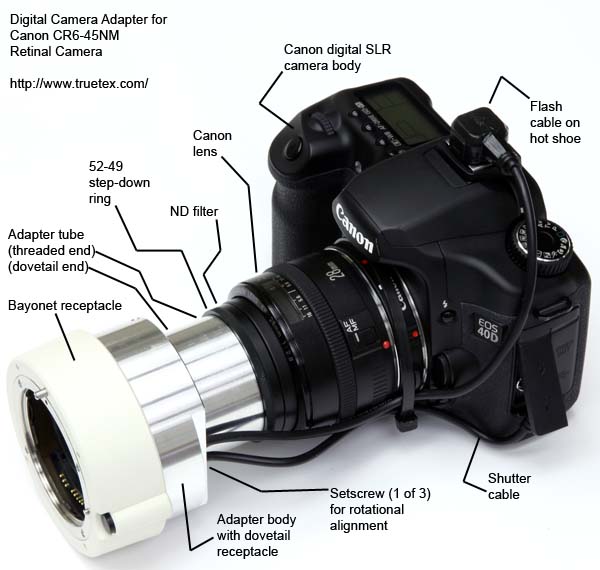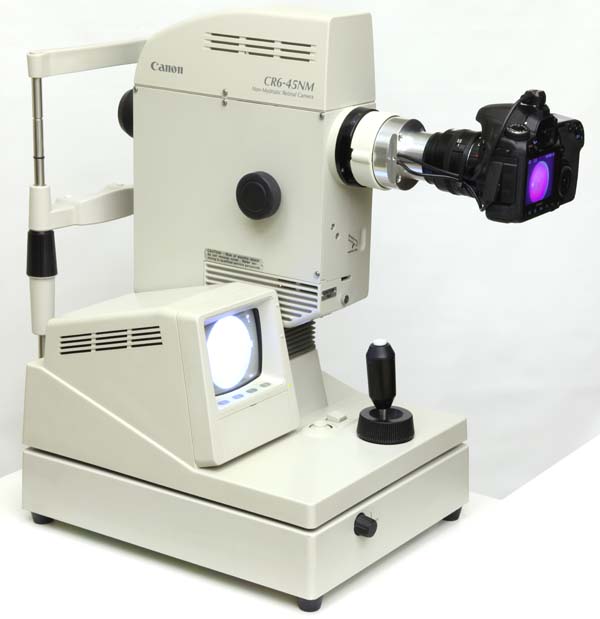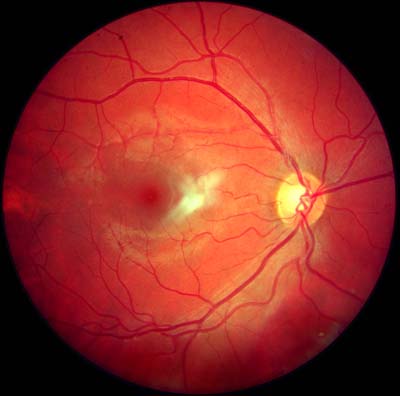INSTALLING AND OPERATING THE CANON CR6-45NM
NON-MYDRIATIC RETINAL CAMERA
DIGITAL UPGRADE KIT
Richard J Kinch
http://www.truetex.com/
Revised: August, 2018
Description and contents:
The digital upgrade kit for the Canon CR6-45NM non-mydriatic retinal camera provides
an attachment and electronic interface for a standard digital SLR camera
in place of the original Polaroid film attachment.
The kit contains the following items:
- Main adapter assembly (EF receptacle, adapter body and tube, cables, 49-52mm step-up ring, 52mm ND4 neutral density filter).
- 1.3mm hex key (for rotational alignment).
- Cable ties (for tucking cables into the finished assembly).
- White paper label with permanent adhesive (for locking focus calibration).
- A printed copy of these instructions.
The upgrade requires the following standard Canon camera equipment which may be obtained from
retail camera and electronics retailers:
- Canon EOS digital SLR camera body.
- Canon EF 28mm f/2.8 autofocus wide angle lens.
- Canon auto focus extension tube EF 12 II.
Any model Canon camera body is compatible with the adapter. Suggested less-expensive models are the Canon Rebel T2i, T3i, or XS.
These perform well with the adapter and are all that is needed for retinal photography.
If you expect to use the camera for conventional photography off the retinal instrument, consider
the mid-range Canon line, such as the Canon 60D or 7D, which provide sturdier construction and a much better viewfinder.
High-end models like the Canon 5D Mark II are compatible but will outcrop the image.
Any model camera body, including the least expensive, outperforms the theoretical resolution of the Canon
retinal instrument, so additional camera resolution will not improve
the retinal photography performance.
The Canon lens and extension tube listed above are specifically required for the adapter.
Other lenses or extensions will not focus or properly crop the instrument image.
We manufacture this adapter using the original Canon CR-PC Polaroid attachment, which you submit to us for retrofit.
We combine new custom parts (which we manufacture in the USA) with certain parts disassembled from the old film attachment
to create the new digital adapter assembly.
The adapter optics consist entirely of genuine Canon lenses,
including some of the original Canon elements plus a new Canon digital EF lens on a standard Canon digital camera.
This design ensures a high-quality digital image exceeding the resolution, color, and contrast of the film version.
The reliability of the basic Canon retinal instrument is such that you can expect, with proper maintenance,
many years of future service from the upgraded unit.
Our use of standard digital camera components provides easy service and upgrades with off-the-shelf parts, and a wide
range of support in photographic software for image management and enhancement.

Photo 1. Digital camera adapter for Canon CR6-45NM retinal camera,
shown with Canon lens and digital camera body.
|
The adapter provides mechanical, optical, and electronic features.
The adapter assembly, together with the standard camera lens and digital camera body, establish a properly scaled and positioned image
for digital photography, with two-way electronic signaling to synchronize the camera shutter with the
instrument flash.
Mechanically, the adapter provides a Canon EF bayonet receptacle with electrical contacts on the
input side, and a 52mm filter thread attachment on the output side.
Optically, the adapter includes a portion of the original attachment optics which are supplemented
by the digital camera lens.
Electronically, the adapter provides electrical connections to the Canon instrument via the
bayonet "pogo" pins, which connect to an electronic interface circuit board, which is connected
to a camera remote cable and flash sync cable exiting the rear of the adapter.

Photo 2. Canon CR6-45NM retinal camera with digital camera upgrade installed.
|
Installing the adapter:
- Set the MF/AF switch on the Canon 28mm lens to MF (manual focus). This MF setting is always used with this adapter.
Do not switch the lens back to AF, or you may have to recalibrate the focus.
- Turn the lens focus ring to set a nominal focus adjustment of 0.45 meters (between the 0.4m and 0.5m marks) as
indicated on the lens distance scale.
- Attach the Canon EF 12 II extension to the rear of the Canon 28mm lens.
- Carefully thread the Canon 28mm lens onto the neutral-density filter which should already be attached to the rear of the adapter.
Take care starting the threads, as they are very fine and the lens receptacle is plastic.
Tighten the threaded connection gently until it first stops. Do not overtighten this connection or it may be difficult
to unscrew later.
- Attach the Canon digital SLR camera body to the EF 12 II extension.
You should now have the components assembled as shown in Photo 1 above.
- Attach the adapted camera and lens to the Canon retinal instrument. Rotational alignment of the camera body will
likely be tilted until you adjust it in the next step.
- Align the digital camera rotationally to the instrument as follows.
Loosen the setscrews very slightly to allow the adapter tube to rotate,
while holding the camera and lens in case the tube separates from the body.
Rotate the tube (with attached camera lens and body) so the camera body is level.
Make sure the threaded filter connection is still snug.
Tighten the setscrews while holding the SLR camera level.
Make sure that the dovetail tube is flush against the adapter body, since this dovetail attachment is all that is
holding up the camera to the instrument.
- Connect the remote shutter and hot shoe cables to the digital camera as follows.
Observe that the remote shutter is a 2.5mm diameter plug, which Canon designates an E3 connector.
Insert this plug into the remote shutter receptacle on the left side of the camera under the rubber flap.
Attach the hot shoe connector to the camera's hot shoe on the top center of the camera.
- Turn on the SLR camera and establish the following camera settings (consult the camera user's manual for detailed instructions):
- Set the mode dial to the "M" (manual) mode setting.
- Set 1/20 SEC exposure time.
- Set the widest lens aperture of F2.8.
- Set ISO 100 speed.
- You may shoot and review photos with the stand-alone camera and memory card.
Or you may choose to optionally use a tethered PC or network file transmission to
store images immediately on a computer and review images instantly in high-resolution..
- Turn on the retinal instrument and observe that it starts up and charges the flash normally.
The video display should indicate "PC" for Polaroid camera.
Take photos of a test target such as a business card taped across the headrest posts, or a model eye.
Do this in a darkened room, illuminating the test target with the infrared light of the instrument,
not ambient room light (viewfinding with ambient light instead of infrared will not indicate a proper focus
in the video viewfinder).
Confirm that the instrument joystick button triggers the digital camera shutter, and that the instrument flash
subsequently fires.
Confirm that the digital photos are in focus when the test target is focused.
- Proceed with testing on a cooperative live subject eye with good dilation.
Collimate the instrument to the subject pupil, and focus carefully.
The "PC-" flash intensity setting is suitable for most eyes.
After you take a picture, check the digital image for focus and proper exposure.
- Set up tethering or network file transmission for your digital camera, if you have chosen such methods.
- Use the cables ties supplied to tuck the shutter and flash cables out of the way against the lens and camera body.
Parfocal focus calibration:
If you are focusing the Canon instrument with a proper technique on the patient eye properly using the infrared focus indicator, but your digital photos
are consistently out of focus, then you should recalibrate the parfocality of the camera and its lens to the retinal camera focus.
Trial-and-error method:
It may be simplest to set a parfocal focus calibration by trial-and-error as follows.
Start with turning the Canon 28mm lens focus ring for a 0.45m setting on the lens indicator.
Carefully focus the instrument on a test subject and take a photograph.
Make small modifications to the Canon 28mm lens focus ring setting,
and take more test photos, until you determine an optical setting.
While this process may be tedious, it may be simpler than disassembling the adapter as in the following procedure.
Disassembled tube method: For a definite focus calibration, use the following disassembly procedure instead of the trial-and-error method.
- Separate the tube part of the adapter from the body as follows (if not supplied already separated):
Observe the three radial setscrew holes around the outside of the shiny aluminum body of the adapter.
Down inside these holes are tiny setscrews which you will loosen and tighten with the 1.3mm hex key (provided).
These setscrews capture and fix the dovetail end of the tube in the recess of the adapter body by locking against the (hidden) dovetail taper.
Loosen the setscrews several turns, just enough to release the dovetail-to-recess fastening. Separate the dovetail tube from the adapter body.
- Observe that the tube has a dovetail end versus a threaded end. The threaded end is furnished with a 49-52mm step-up ring and 52mm filter.
Attach the dovetail tube to the digital camera lens by firmly mating and screwing the 52mm outside-threaded end of the filter to the inside-threaded filter
threads on the front of the Canon lens. Take care when starting these fine threads, as they are easily damaged.
- Calibrate the Canon lens focus as follows.
- Calibrate the dioptric adjustment of the Canon digital SLR viewfinder for your eyesight.
(See "Adjusting the viewfinder for clarity" in the Canon SLR instruction manual.)
- Stretch a piece of Scotch transparent tape across the dovetail end of the tube, so that the edge of the tape
is close to the center of the tube. This tape will act as a temporary focusing target.
- Look through the SLR viewfinder and adjust the focus ring on the 28mm lens so the edge of the Scotch tape is focused.
That is, you are setting the focus of the camera lens to the end of the tube, using the edge of the Scotch tape as a target.
- Lock this manual focus setting by placing a trimmed bit of the white self-adhesive paper label across the movable and fixed
portions of the lens focusing ring. The focusing ring should be fixed in position by this piece of adhesive label, so that the
focus calibration now established does not change. Thus the paper label "locks" the focus, and remains permanently on the lens.
- Remove and discard the tape which was used as the temporary focus target from the open end of the dovetail tube.
- The focus calibration should now be established.
This focus calibration is critical. It makes the digital camera focus parfocal with the instrument image.
If this focus calibration is off, every digital photo you later take will be out of focus.
- Note and record the reading of the numeric focus scale on the lens. If the focus ring should somehow move, you can reestablish the
focus calibration by moving the focus ring back to this reading, rather than repeating the full calibration procedure above.
- Insert the dovetail end of the tube back into the adapter body and tighten the three setscrews just enough so that the
tube dovetail is definitely captured in the adapter body, but not completely snug.
Additional notes:
- Exposure is primarily controlled by setting the ISO speed setting of the camera, secondarily with the aperture (F-stop) setting of the lens,
and if necessary by changing the density of the neutral density (ND) filter by changing the filter itself.
Proper exposure is best verified by examining the photo histogram and confirming the general impression of the photo appearance.
For a typical eye, the ISO 100 speed and ND8 filter with F2.8 lens aperture should yield an ideal
digital exposure histogram which is spread across the 25 to 50 percent (2nd quartile) intensity range. Histograms heavy in the darkest
quartile will look underexposed and lacking the more shadowy details,
and those heavy in the third or fourth quartiles will be overexposed and lacking contrast.
If exposures are consistently too light with the least sensitive ISO setting (ISO 100),
you can try a smaller manual lens aperture settings (higher F number) until vignetting appears.
While an ND8 filter is typically an appropriate compromise, using lighter filters (lower ND numbers) or darker filters (higher ND numbers)
will adjust the range of exposure available with camera settings.
Multiple filters can be additively stacked for intermediate ND values, although this will require recalibrating the focus and adjusting the rotation with
the radial setscrews.
- Proper calibration of the adapter focus is critical to getting focused pictures.
If your photos are consistently out of focus, check the focus calibration using the procedure described above in the installation.
- The adapter tube is offset from the center of the instrument bayonet attachment axis.
This is because the instrument image is similarly off center. This offset originally provided an area on the 35mm film exposure
for the image data record. The digital adapter does not transmit this to the digital image, since the date and time are
recorded as properties of the image file.
- Dust on the field lens in the adapter will appear as dark spots on every digital photograph.
Cleaning any dust from the field lens will eliminate the spots, although it is difficult to completely eliminate all of them.
Access the front side of the field lens for cleaning by removing the adapter from the instrument.
Access the rear side of the lens by loosening the setscrews and removing the adapter extension tube.
- Canon digital SLRs have one of two types of shutter remote connectors, known as E3 (a 2.5mm subminiature phone jack) and
N3 (a three-pin round connector). The adapter is normally supplied with an E3 plug, for which we can also supply
an N3 adapter, if you choose to use a Canon camera body with the N3 instead of the E3 connection.
Copyright 2009, 2011, 2018 Richard J Kinch.



